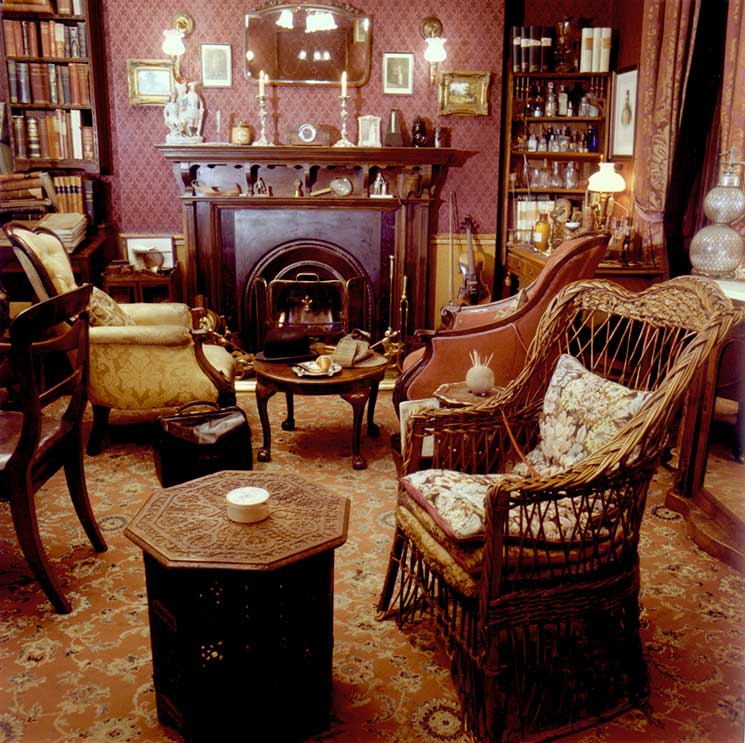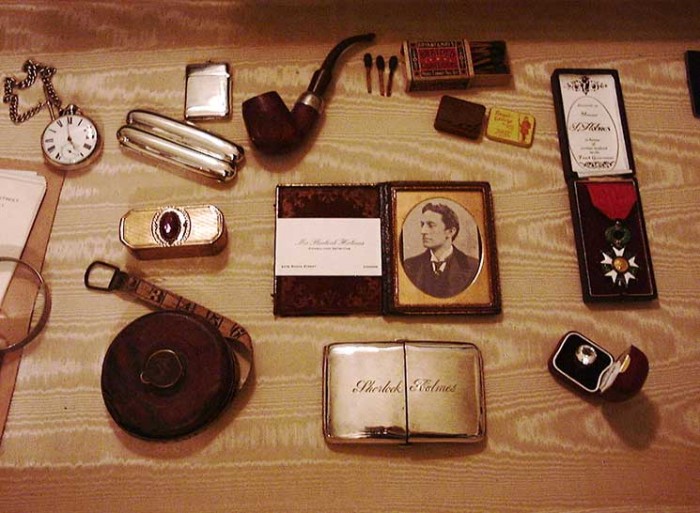Discover the Great Detective at the Sherlock Holmes Museum
Nicola Rayner dons a deerstalker and magnifying glass to follow the trail to London’s Sherlock Holmes Museum
It’s one of the most famous addresses in London, if not the world, but while most of us don’t have a precise idea of what 10 Downing Street or No 1 London look like inside, the interior of 221B Baker Street is a familiar friend.
“Cheerfully furnished, and illuminated by two broad windows,” as we are told in A Study in Scarlet, the first-floor study shared by Britain’s most famous fictional detective, Sherlock Holmes, and his friend and biographer, Dr Watson, is immediately recognisable, with two chairs facing its cosy fireplace and a sofa against the opposite wall (which bears a patriotic “VR” (Victoria Regina) inscribed in bullet holes, as described in The Musgrave Ritual).
The most famous room in the Sherlock Holmes Museum is not a spacious one (Holmes is able to emerge from his bedroom next door and take one spring across the study to close the curtains) but, everywhere you look, there’s something to recognise from Sir Arthur Conan Doyle’s stories. “You can touch everything except the knife, the violin and the syringe,” we’re told by a friendly-looking Victorian maid (her counterpart outside is a period-style policeman guarding the entrance).
There is a reason for the familiarity. Sherlock Holmes is one of best known fictional personalities in the world – it has been said he shares the spotlight only with Mickey Mouse and Santa Claus – and he made his screen debut in 1900, in Sherlock Holmes Baffled, a 49-second-long silent film, followed in 1905 by The Adventures of Sherlock Holmes (shown in Britain as Held for Ransom). “After this,” Michael Pointer writes in The Public Life of Sherlock Holmes, “scarcely a year passed without Sherlock Holmes appearing on the screen somewhere in the world.”

Among the most famous screen representations of Holmes in the past are William Gillette, Basil Rathbone and Jeremy Brett, but the latest actor to make the part his own is Benedict Cumberbatch, who returned to our screens with Sherlock: The Abominable Bride, a one-off episode set in London in 1895, on New Year’s Day.
The BBC show is, in fact, filmed in North Gower Street in Euston with the nearby Speedy’s Café on the to-see list for admirers. However the number one destination for scores of new fans – and fanmail – is still 221B Baker Street, which houses the Sherlock Holmes Museum.
First things first: the eagle-eyed will notice that the Sherlock Holmes Museum is actually located at what was once 239 Baker Street. The building was reallocated the number 221B when it opened in 1990 but, interestingly, 221B Baker Street did not exist in 1887 when A Study in Scarlet was published, marking the first appearance of Holmes and Watson – back then Baker Street house numbers didn’t extend that far.
Nevertheless, the museum building is well suited to its task, not least because from 1860 to 1934 it was registered as a lodging house – like that of Mrs Hudson, Sherlock and Watson’s landlady, who rented the rooms to the pair between 1881 and 1904. The Georgian house fits the bill from the 17 steps from the ground-floor hallway to the first-floor (“I know there are 17 steps, because I have both seen and observed,” says Holmes), to the lovingly recreated study, a treasure trove for newcomers and dedicated fans alike.
The latter will have fun spotting their own “clues” from the stories – chessboards, chemistry equipment and case notes among them. Portraits of the ill-fated General Charles Gordon and Henry Ward Beecher adorn the walls – the pictures are key to Holmes’ reading Watson’s thoughts in The Cardboard Box. A more personal memento from A Scandal in Bohemia can be found propped on the mantelpiece: a photograph of “The Woman” – Irene Adler, who famously outwitted the great detective.

On the next floor, Mrs Hudson’s and Watson’s rooms are more sparsely furnished, with display cabinets featuring photographs, letters and memorabilia: Sherlock’s medal from the French government, a wide selection of knives, a revolver concealed in a Bible, a bust of Napoleon and a hungry-looking hound. All the museum’s artefacts are sourced from the era or have been donated to the museum (though as to where the Engineer’s Thumb or the severed ears from The Cardboard Box came from, the mind boggles).
Mrs Hudson’s room features a shrine to her pragmatic nature and pastimes, while Watson’s displays taxidermy and medical equipment, as well as reminders of his military past. A diary entry is open to a page of notes for The Hound of the Baskervilles, while pride of place is given to the original cane chair used by the Victorian artist Sidney Paget, who illustrated Conan Doyle’s stories for The Strand magazine, for The Greek Interpreter.
Look out for the silver steed – a nod to the story Silver Blaze (where the famous phrase “the curious incident of the dog in the night-time” comes from). On the third floor, the stories make a more literal appearance in the form of wax figures. Irene Adler, the creepy blackmailer Charles Augustus Milverton, Sherlock’s nemesis Professor James Moriarty (“the Napoleon of Crime”) and even the Hound of the Baskervilles appear as large as life.
Of course, part of the fun is playing amateur sleuth oneself – separating Sherlock “fact” from Sherlock “fiction”. Apparently Holmes never did say, “Elementary, my dear Watson.” And he “never actually wore the deerstalker”, we are told as we photograph ourselves with the hat and pipe that are temptingly laid out in front of the fire. The most serious fans, however, take their dedication to a new level. Players of “the Great Game” believe that the world’s most famous detective was not, in fact, fictional at all. His presence is so strongly recreated at the museum that perhaps, after all this time, the case remains open…




